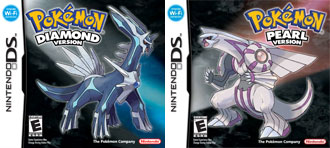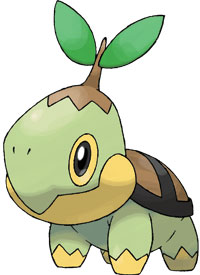Pokemon Diamond and Pearl game review
- Click for Pokemon Diamond and Pearl game tips
- New to Pokemon? Click here for a Pokemon primer
- Get answers to your questions from the Games Guru
Pokemon Diamond and Pokemon Pearl begin much like any Pokemon game — you’re a kid who dreams of training Pokemon, and you run into a kindly professor who makes that dream come true. In this case the professor is named Rowan, not Oak or Elm, the professors from past Pokemon games.

THE LOWDOWN Graphics: 7.0 Sound: 6.0 Gameplay: 9.0 Value: 9.0 Overall Score: 8.0 out of 10.0 Pros: The best thing about Pokemon Diamond and Pokemon Pearl is that they look and feel like a good old Pokemon game. The controls are the same, the goals are the same and the play is similar. Cons: The new monsters are not especially cool, and some changes to the game aren’t that fun. |
There are other story changes as well.
In the past, games began with the professor inviting you to his lab and giving you a Pokemon. As Diamond and Pearl open, you and a friend are exploring by a lake. You find a briefcase in tall grass and are attacked by two bird Pokemon called Starlys. Fortunately for you, that briefcase belonged to Professor Rowan, and you find three Pokeballs inside.
Your string of good fortune continues because after you defeat the wild Starlys, Professor Rowan informs you that the Pokemon you used on the Starlys has bonded with you.
Thus begins two Pokemon journeys: yours and your friend’s. (I’m not sure what your friend’s name will be. The game offers the names Barry and Tyson, among others. I named my friend Doofus, and he lived up to his name.)
You walk from town to town in a land called Sinnoh finding, capturing and training little monsters that you then enter in fights with other Pokemon. Sinnoh is vast and has some really fun puzzles, and some of the gyms make great use of the DS’s ability to render 3D.
As in other Pokemon games, winning fights earns you money, and it earns your Pokemon experience points that make them stronger and sometimes evolves them into more advanced versions of themselves.
One thing Pokemon games have always done right and continue to do right is to offer a certain rock-paper-scissors approach to combat. In many of the past games, you chose between a Charmander, Squirtle and Bulbasaur for your first beast. If you took Charmander, a dragon, you could cook Bulbasaur, the plant Pokemon, in fights—but Squirtle, the water Pokemon, had your number. Squirtle, however, was vulnerable to Bulbasaur’s plant attacks. It all evened out.
Diamond and Pearl have that same rock-paper-scissors balance. The first three Pokemon are fire, water and plant creatures: Chimchar, Piplup and Turtwig.
One thing that stands out about Diamond and Pearl on Nintendo DS is how similar they are to the old Game Boy games. They still have the same turn-based fighting system, the same basic exploration and dialog controls. The game has changed only on the surface.
You can control some parts of Diamond and Pearl using the touch pad controls on the bottom screen, but I found it wasn’t worth the trouble. I played the game using standard Game Boy controls.
Instead of using the select and start buttons to bring out registered items, look for inventory and access your Pokedex, you now have X and Y buttons.
In past Pokemon games, you turned berries into blocks to feed them to your Pokemon. You did this by playing a mini-game in which you pressed a button as a centrifuge spun your berries around.
In Diamond and Pearl, the berry blender is replaced with a pot in which you stir your berries using your stylus as you cook them into Poffins. It’s a cute game that’s not bad, but it’s not especially fun, either.
Overall, if you liked past Pokemon adventures, you should like Diamond and Pearl. They preserve the old games well.
Change Can Be Good: Diamond and Pearl introduce some cool changes. One of these is a new Pokeball called a Heal Ball that lets you catch, heal and use wild Pokemon on the fly. If you’re going into an area where your favorite Pokemon run wild, you can leave an open slot in your party and catch that Pokemon with a Heal Ball. As soon as it’s yours, you can use it.
The biggest changes involve DS’s WiFi ability. In the past, you either needed to link Game Boys with a cable in order to battle other players or swap Pokemon with a friend. Later, Nintendo released a wireless controller for Game Boy, but you still needed to have your friends right there to swap or fight.
DS, with its WiFi compatibility, lets you take fights to the Internet. There’s even a wireless headset that lets you talk to friends as you battle them.
And Change Can Be Not-So-Good: If there’s one place Diamond and Pearl fall a bit flat, it’s in the area of new monsters. Between them, Diamond and Pearl offer more than 100 new monsters to collect. But these new monsters aren’t as cool as most of the originals. You begin with Turtwig, an adorable baby turtle with a tree growing from its head; Chimchar, a baby monkey with a flame on its tail; and Piplup, a baby penguin.

Turtwig, seen here in concept art, is one of the new and overly adorable starter creatures in Diamond and Pearl. He’s sort of a replacement for Bulbasaur. |
These creatures are too cute to be cool — or even evolve into something cool.
Of course, there were some goofy original Pokemon. Let’s face it—Mr. Mime was downright embarrassing. But the new monsters include Burmy, which looks like a weed and evolves into Wormadam, which looks like a Chia Pet. That’s not to say you can’t get a kick out of the Diamond and Pearl Pokemon: Nintendo has added new animations to the mix, some of which have hilarious results. The one that really got me is the animation for Machop. It’s supposed to look like he’s boxing, but to me, it looks like he’s making funny duck-like noises by placing his right hand in his armpit and flapping his left arm over it.
On a less comical note, Nintendo has expanded the Pokemon contests in Diamond and Pearl, making them a bit dull.
More: Game tips | Pokemon primer | Games Guru Q&A
Leave a Comment